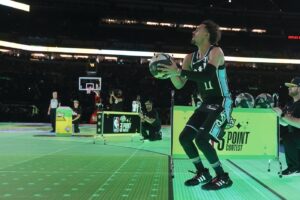Hardwood is basketball’s longtime foundation. A German company would love to change that to glass
By Canadian Press on April 2, 2025.
Chris Thornton loves talking about playing basketball on the most fragile-sounding of surfaces: glass.
Thornton is managing director of the Americas division of
ASB GlassFloor, a German company building floors made of fused-together layers of safety glass covering LED panels. The courts are a far more dynamic visual feast, with customized playing lines, logos, colors, animated graphics and advertisements for multiple sports.
In basketball, where wood is still king, Thornton sees growth potential for glass courts — already showing up in
the NBA and
internationally — as a tech-driven alternative to the sport’s long-running hardwood foundation.
“I use this analogy a lot: We’re at the initial stages of the iPhone being launched,” Thornton said. “Way back when Apple did that, the design of the hardware has changed, but more importantly the original iPhone was just a phone, a text device and music player. Now you’re running your entire life and communicating to the world on it. I see this in the same regard.”
But it’s glass!
It seems strange at first blush — big, strong athletes jumping and running across a court of glass while “pounding the rock” and even diving on the floor. That is a future ASB GlassFloor company envisions, citing technology improvements allowing for a safe and viable surface featuring stunning visuals that can be changed
with a few swipes and taps of a smartphone or tablet app.
Thornton said the glass surface has give and flexibility exceeding that of wood, aided by a spring-action design to the aluminum and steel framing beneath the LED paneling. There’s also a ceramic coating with dots etched into the glass, offering grip, and a consistent surface without “dead spots” or other quirks that can occur with wood courts.
That combination has the company touting enhanced safety potential for athletes, even in more easily spotting sweat to wipe up.
“There’s a stigma about the glass: ‘Oh my gosh, it’s going to break, it’s harder, people are going to break the glass, they’re going to fall through it,’” Thornton said. “It’s actually quite the opposite.”
The visuals are the bigger selling point. Arena managers could easily update a court’s look instead of using space storing hardwood stacks for multiple designs and paying for labor to install or update them. Or coaches could set up their own practice regimens with on-court visual cues.
And yes, a team could even opt for a hardwood-panel look in a nod to tradition.
The trade-off? A bigger price tag than a wood counterpart. Thornton didn’t specify an amount but pointed to potentially selling leases to the courts, saying the company has had “advanced” talks with college teams and leagues.
At Connor Sports, a Michigan-based company that makes the hardwood courts for the men’s and women’s Final Four, technical director Jason Gasperich referenced that higher cost. He noted that roughly 750 of the 800 courts his company typically builds and sells per year might end up in elementary and high schools “where they just don’t have the budget for that.”
Still, he also gave a tip of the cap to the technology.
“Nonetheless, they’re still super interesting, unique,” Gasperich said. “And there’s things you can do with digital that you can’t do with a traditional wood floor.”
Getting looks
Glass LED courts are already in home arenas for
Bayern Munich in Germany and Panathinaikos Athens in Greece. They’ve also been used in events
by governing body FIBA.
In the U.S.,
Kentucky used one in October for its “Big Blue Madness” event marking the ceremonial season start for Wildcats basketball.
“I love everything about the versatility of this floor,” men’s coach Mark Pope said in
video posted by ASB GlassFloor capturing reactions as players tested it out in Rupp Arena.
“I don’t know what I was expecting, but it squeaks like a real basketball court,” women’s player Cassidy Rowe said in the video. “It just functions like a normal basketball court, but it’s showing our picture, which is crazy.”
The NBA offered a showcase look
during the 2024 NBA All-Star weekend, holding its skills competition, 3-point contest, dunk contest and shooting matchup between Stephen Curry and Sabrina Ionescu on one in Indianapolis.
By December, the company had set up a training facility in Orlando allowing
NBA teams in town to play the Magic a chance to workout on the glass court and offer feedback. Thornton, who said the NBA has bought a minority stake into the company’s Americas division, estimated more than 100 players and coaches have tested it so far.
“As we integrate with the other data providers in both the NCAA and NBA, we are only going to get better and better with what improving what you can do on an ASB GlassFloor,” he said. “The focus now up to today has been getting a surface that is comfortable for the athletes to play on, and we’ve done that.”
___
AP March Madness:
https://apnews.com/hub/march-madness and AP technology coverage:
https://apnews.com/technology
Aaron Beard, The Associated Press
29
-28



